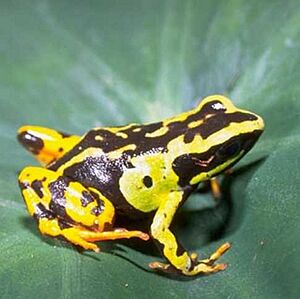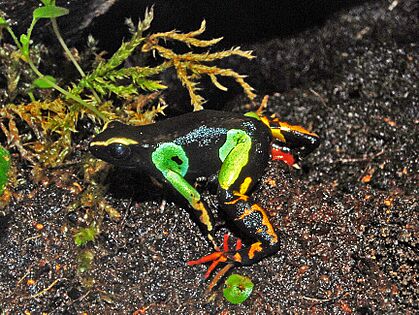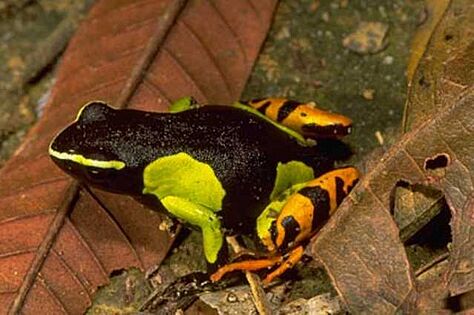Madagascan mantella facts for kids
Mantella madagascariensis, often called the Malagasy painted mantella or Madagascar golden frog, is a small, colorful frog found only on the island of Madagascar. It belongs to a group of frogs known as Mantellidae.
Quick facts for kids Madagascan mantella |
|
|---|---|
 |
|
| Conservation status | |
| Scientific classification | |
| Genus: |
Mantella
|
| Species: |
madagascariensis
|
| Synonyms | |
|
|
Where It Lives
This special frog is found only in Madagascar, which means it is endemic there. You can find it in the east-central parts of Madagascar, in high-up areas. These places are usually between 700 and 1,050 meters (about 2,300 to 3,440 feet) above sea level. Some specific spots include areas near Niagarakely and south to Ranomafana.
Sadly, this frog is facing threats. Its home is shrinking because of habitat loss, which means its natural living areas are being destroyed. It might also be threatened by people collecting them to sell as pets.
Its Home Environment
The Malagasy painted mantella lives in different types of forests and near rivers.
- It likes warm, wet forests in low-lying areas.
- It also lives in wet forests found on mountains.
- Rivers are important to these frogs, especially for breeding.
What It Looks Like
These frogs are quite small but sturdy.
- Males are usually about 21 to 22 millimeters (0.8 to 0.9 inches) long.
- Females are a bit bigger, around 24 to 25 millimeters (0.9 to 1 inch) long.
Their colors and patterns can vary a lot, but they often have black and yellow stripes or patches.
- Their body is usually blackish, especially on their back.
- A green or yellowish stripe often runs along their head.
- Their upper legs (femur and humerus) are usually yellow to green.
- Their lower legs and feet (tibia, tarsus, and foot) are reddish-orange with blackish spots.
- You might also see yellow-green blotches on their sides, near their front legs.
Some scientists think that Mantella madagascariensis might actually be a group of very similar species that are hard to tell apart. This frog is also very similar to two other species: Mantella pulchra and Mantella baroni.
- Very similar species:
Life and Habits
We don't know a lot about the daily life of these frogs.
- They are active during the day and spend their time on the ground.
- They prefer to live in forests or at the edges of forests, especially near streams.
- When it's time to have babies, the frogs breed in streams.
- The female frogs lay their eggs on land, but the tiny baby frogs (larvae) then develop in the water of the streams.
- Like all Mantella species, these frogs have special chemicals in their skin. These chemicals can be irritating or harmful if touched or eaten, which helps protect them from predators.






